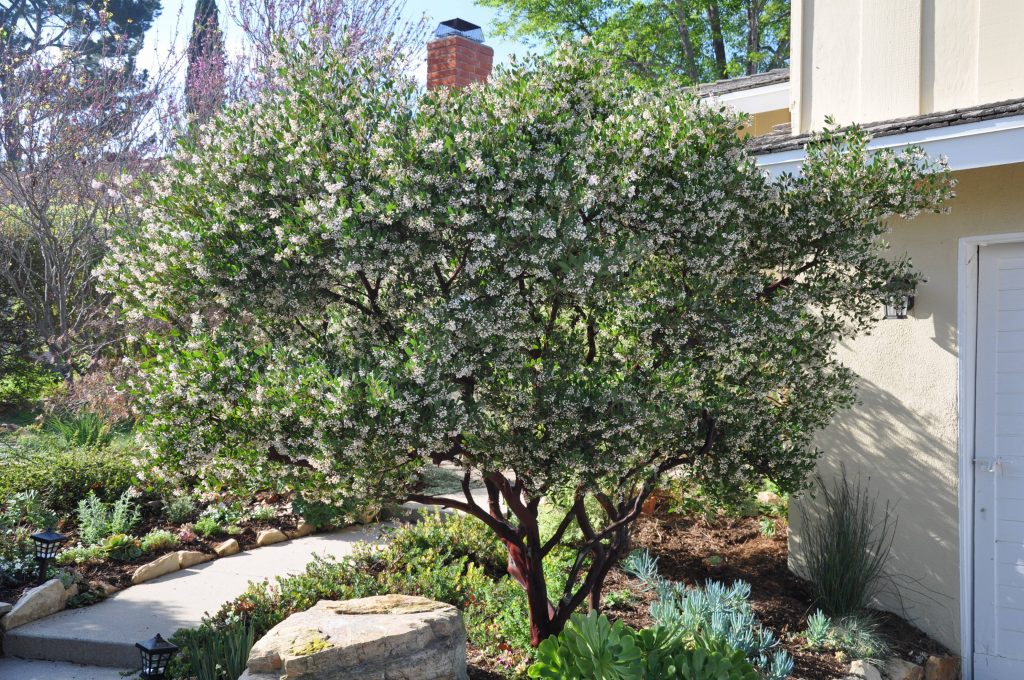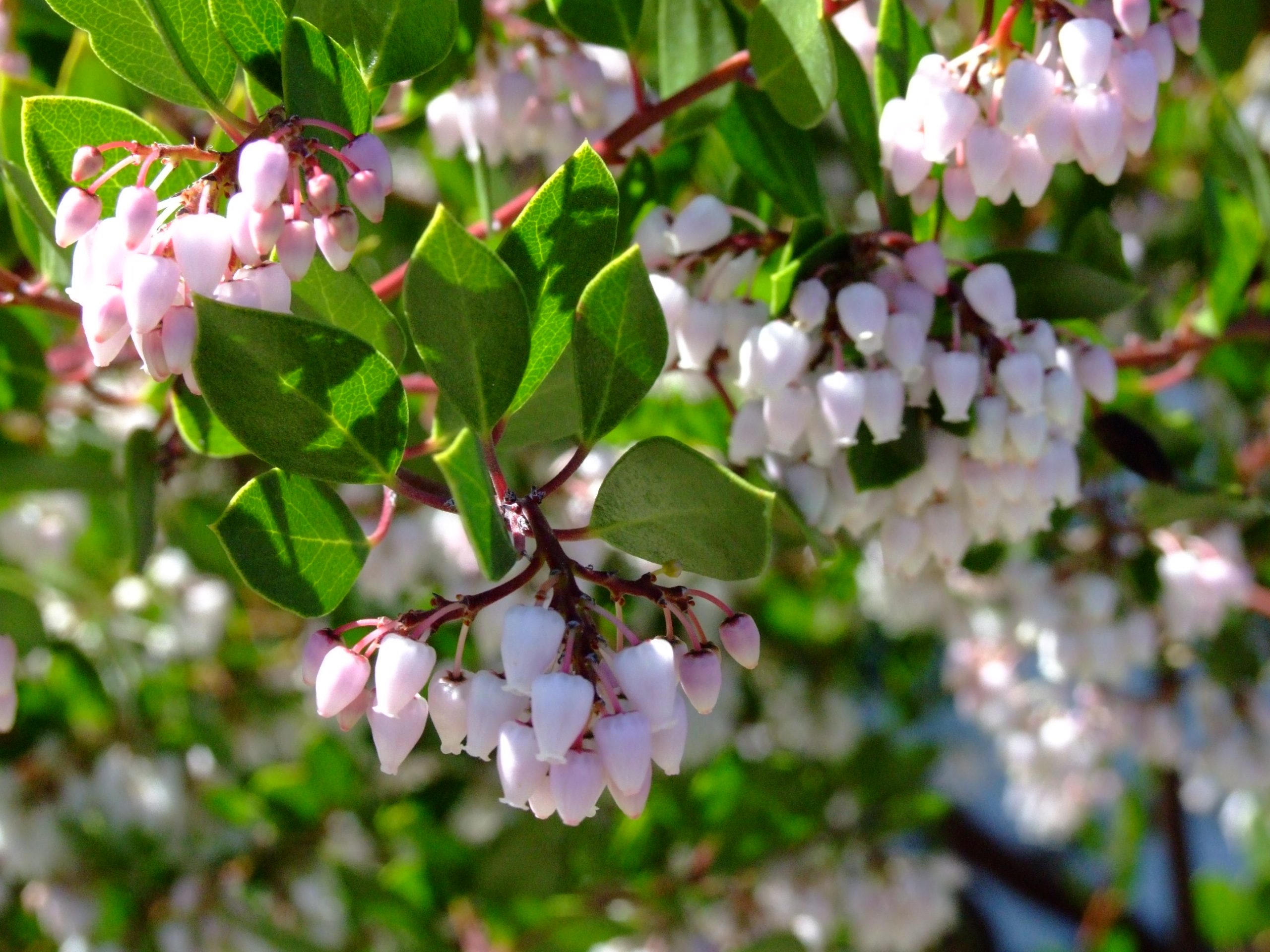Howard McMinn Manzanita

Arctostaphylos den. ‘Howard McMinn’, commonly known as Howard McMinn Manzanita, is a striking evergreen shrub native to the coastal regions of California.
Celebrated for its attractive bark, urn-shaped flowers, and drought tolerance, Howard McMinn Manzanita adds elegance and resilience to gardens and landscapes.
In this comprehensive article, we will delve into the botanical intricacies, habitat preferences, life cycle, ecological and cultural importance and care guidelines for Arctostaphylos den. ‘Howard McMinn’.
Botanical Description
Howard McMinn Manzanita is a dense, rounded shrub that typically reaches heights of 4 to 6 feet tall and wide, with some specimens growing larger under optimal conditions.
The plant is characterized by its smooth, mahogany-red bark that peels away in thin, papery layers, revealing a cinnamon-colored underlayer.
The leathery, oval-shaped leaves are dark green and glossy, providing year-round interest in the landscape.
In winter and early spring, produces clusters of small, urn-shaped flowers that range in color from white to pale pink.
These delicate flowers attract bees, butterflies, and other pollinators and add a charming touch to the winter garden.
Habitat and Distribution
Howard McMinn Manzanita is native to the coastal regions of California. It is found in a variety of habitats, including chaparral, coastal scrub, and oak woodlands.
It is distributed along the central and northern coast of California, from Monterey County to Mendocino County, where it thrives in well-drained soils and full sunlight.
Is adapted to the mild maritime climate of its native habitat, tolerating salt spray, wind, and occasional coastal fog.
It often grows on slopes, hillsides, and rocky outcrops, providing erosion control and habitat for wildlife.
Life Cycle and Phenology
As an evergreen shrub, Howard McMinn Manzanita exhibits year-round growth and interest in the landscape.
Growth occurs primarily in spring and summer, with new leaves and flowers emerging from dormant buds in response to increasing daylight and temperatures.
Flowering typically occurs in late winter to early spring, depending on local climate conditions, with peak bloom lasting several weeks.
The urn-shaped flowers are pollinated by bees and other insects, which visit the blooms to collect nectar and pollen. After flowering, Howard McMinn Manzanita may produce small, red berries that are relished by birds and wildlife.
Ecological and Cultural Importance
Howard McMinn Manzanita plays a vital ecological role in its native habitat, providing food and habitat for a variety of wildlife species.
The flowers attract pollinators such as bees, butterflies, and hummingbirds, contributing to the health and diversity of local ecosystems.
Additionally, the dense foliage and branching structure of this plant provide cover and nesting sites for birds and small mammals.
Culturally, Manzanitas have been cherished by indigenous peoples for centuries for their medicinal properties, as well as for ceremonial and decorative purposes.
In gardens and landscapes, people value Howard McMinn Manzanita for its ornamental bark, attractive flowers, and drought tolerance.

Caring for Arctostaphylos den. ‘Howard McMinn’
Sunlight
Plant in a location that receives full sunlight to partial shade. It prefers abundant sunlight for optimal growth and flowering.
Watering
Water young plants regularly during the first growing season to establish a strong root system.
Once established, is drought tolerant and generally requires minimal irrigation. Water deeply during prolonged dry spells, especially in inland areas.
Soil
Plant in well-drained, sandy or loamy soil with good drainage.
Howard McMinn Manzanita is sensitive to heavy clay soils, which can cause root rot and other problems.
Amend heavy soils with organic matter to improve drainage.
Pruning
Prune Howard McMinn Manzanita lightly after flowering to maintain a compact, rounded shape and remove any dead or crossing branches.
Avoid heavy pruning, as Manzanitas do not respond well to extensive pruning.
Fertilizing
Howard McMinn Manzanita generally does not require fertilization, especially in nutrient-rich soils.
If desired, apply a balanced fertilizer in spring, following the manufacturer's instructions.
Mulching
Apply a layer of organic mulch around the base of the plant to help retain moisture, suppress weeds, and insulate the roots from temperature fluctuations. Avoid placing mulch directly against the stem to prevent rot and fungal diseases.
By adhering to these care instructions, you can nurture robust Howard McMinn Manzanita shrubs, enhancing coastal landscapes and preserving native flora. Whether for aesthetics, ecology, or culture, its allure endures.
Leave a Reply
You must be logged in to post a comment.